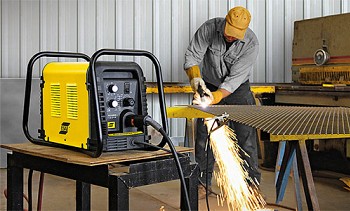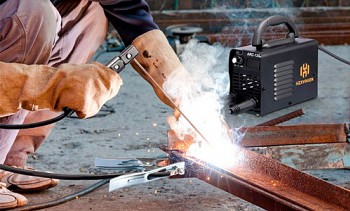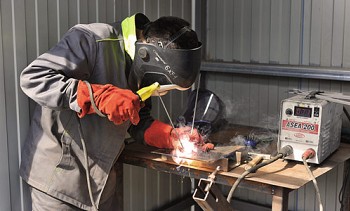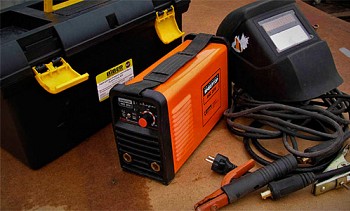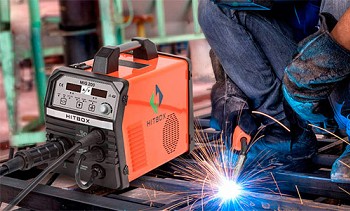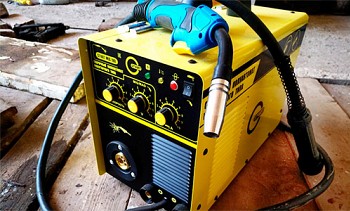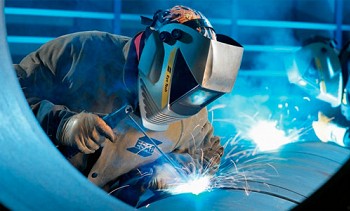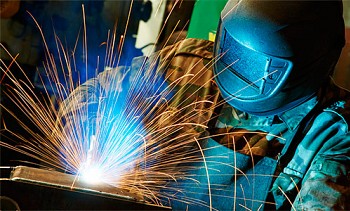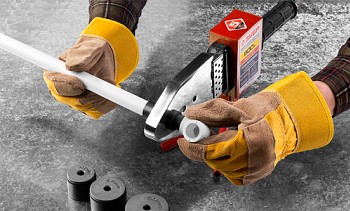In a private house there is always something to cook. These are: a fence, a gate, a gate, a greenhouse, a gazebo, etc. To figure out which welding machine is best for the home, you need to take into account that the cross section of household wiring is limited, and small metals are used in the work. Here are tips on the type of power sources, types of welding and the optimal parameters that will help you choose the right welding machine for working in a private house, at the cottage or in the garage. Here we placed a rating of the best models based on product specifications and welder reviews showing proven equipment.

The selection of goods was carried out on the basis of reviews, opinions and ratings of users posted on various resources on the Internet. All information is taken from public sources. We do not cooperate with manufacturers and trademarks and do not call for the purchase of certain products. The article is for informational purposes only.
Which welding machine is best to buy for a home
In the courtyard of a private house or in the country, you have to work with round and shaped pipes, a corner and sheet metal. Most often, the wall section does not exceed 2-4 mm. On the other hand, it may be necessary to weld the channel with a wall of 6-10 mm. Which welding machine to choose for the home depends on the upcoming tasks, which include the thickness of the material being welded and the types of metals. The equipment is divided by type of power source and welding mode. We will discuss this in order.
Which power source is best for home use?
There are several types of welding power sources. The quality of the seam and the possibility of joining different materials depends on the choice. Consider what is most suitable for welding in domestic conditions.
1. Inverters
They are connected to a 220 V or 380 V network and convert the low-frequency alternating current to direct, and then again to alternating, but with a high frequency. A constant voltage is outputted. The equipment is compact in size and suitable for welding ferrous metals, cast iron and stainless steel. Models with an AC / DC switch are even designed for aluminum welding.

Welding inverter with cover removed.
2. Rectifiers
They can work both from a single-phase and from a three-phase network. They lower volts and increase amps due to transformer coils, and at the output they rectify the current to a constant. They are large and often equipped with wheels for transportation. Easy to weld carbon and stainless steel.

Welding rectifier.
3. Transformers
They work on a similar principle as rectifiers, only without the last phase of the cycle. Welding is carried out on alternating current. Ferrous metals are best brewed. Dimensions of equipment depend on power. There are compact devices for carrying on the shoulder and larger ones for stationary installation.

Welding transformer.
For welding at home or in the country, it is best to choose inverters. They provide a constant current that improves the quality of the seam, and have useful features that make it easy for beginners to work. The price of the product depends on the manufacturer and the capabilities of the device. A cheaper option would be a small transformer, but it is only suitable for non-responsible structures (put up a fence, weld a loop on the gate). They are better off not heating and plumbing because of the alternating current, which increases the spray of molten metal.
What type of welding is best for home use?
In addition to the power source in the equipment, the modes developed for carrying out different types of welding differ. Having delved into their capabilities, we can better understand how to choose a welding machine for the home.
1. MMA
The abbreviation means manual arc welding with coated electrodes. The metal rod melts and creates a seam, and the coating of the electrode forms a protective cloud. After solidification, a slag crust is present on the surface. Suitable for welding ferrous metals, cast iron. When replacing electrodes with specialized ones, it will turn out to cook stainless steel and aluminum. But the quality of the seams is highly dependent on the skill of the user.
The equipment is suitable for welding at home, to put a fence, gazebo, greenhouse, replace the heating pipe. Such models are not expensive.

Scheme of the manual arc welding process.
2. MIG / MAG
Semi-automatic shielded gas welding. Welding is carried out by a torch, from which the wire automatically exits. An inert or active gas is supplied to the nozzle, eliminating the influence of ambient air on the molten metal. Depending on the type of wire, you can weld stainless steel, aluminum, carbon steel. Welding is fast, no seams need to be cleaned.
Semiautomatic devices are justified for welding a house if car body repair is required or a small production of metal doors, barbecues, containers for a shower, fuel, etc. is carried out. Of course, using a MIG welding it will be possible to weld a greenhouse qualitatively, but moving a gas cylinder around the garden is not very convenient . Such equipment is more expensive than MMA.

Scheme of the process of semi-automatic welding.
3. Tig
Arc welding with nonconsumable electrode in an argon medium. The arc burns between the tungsten needle and the product. The machine delivers direct current suitable for welding ferrous metal and stainless steel. Models with switching to alternating current are able to cook aluminum. The seams are smooth, thin and durable.
Such a device for the house will be able to tightly connect the pipes of the water supply, heating, and make containers for liquids. But the cost of welding, compared with MMA, increases due to the use of gas.

Scheme of the argon arc welding process.
4. Universal MMA + MIG / MAG or MIG / MAG + TIG
Universal devices can connect the above modes, welding metal in several ways. This is practical for welding at home, if you have to alternate work with thin and thick metal (weld a sheet with a cross section of 1.0 mm to the gate - MIG will fit, and then connect two channels, 10 mm thick - MMA will do). The use of combined devices at home is justified in the case of welding dissimilar materials. For example, using MMA + TIG you can cheaply weld carbon steel (doors, greenhouses), and close up the mother-in-law in the aluminum pan of the crankcase.

As you can see, what kind of welding inverter is better to buy for the home, depends on the types of materials that are supposed to be welded, and the requirements for the quality of the seam (under pressure, load, or just to keep under its own weight).
Details on all types of welding see in the video:
What characteristics should a home welding machine have?
When choosing an apparatus for welding at home, in a garage or in a country house, it is important to consider the suitability of the equipment for operation in domestic conditions. Here are the best options to help you choose the right product.
Mains voltage
The houses have a single-phase 220 V network, so three-phase devices cannot work from it. Moreover, in remote villages or in the country, often weak power lines are laid, where the voltage drops to 180 V or lower. The same effect occurs when using an extension cord of 30-50 m. The longer the wire, the higher the resistance and lower the current.
Therefore, for operation at home, it is optimal to choose a welding machine with a supply voltage of 140-260 V.Thanks to this, he will be able to work with "subsidence" or with an extension cord.
Open circuit voltage
The voltage of 220 V in welding machines is lowered to 20 V in order to prevent a welder from being struck by electric current when the arc is ignited. But at idle (until the circuit is closed), the higher the current, the easier it is to ignite the electrode.
For experienced welders, this is not a problem, but for beginners it is better to choose devices for the home with an indicator of 70-90 V idling. This parameter will facilitate the excitation of the arc on rusty or painted metal.
Power
The characteristic can mean both welding current for melting metal and power consumption from the network. The first parameter affects the thickness of the melt. If you want to weld only sheet metal with a cross section of 1-2 mm, then 100 A. is enough. For welding a corner and a profile with a wall of 3-4 mm, 120-150 A. A channel with a thickness of 10 mm will be boiled at a current of 200-230 A. It is better buy a welding machine for the house with a margin of power, since it can be lowered, but it can no longer be raised above the factory value. The best option is 160-200 A.
Power in terms of network load is best chosen in the range of 3-6 kW. This will not allow melt the wiring in the house or singe the outlet.
Duration of work - PV
The indicator implies how much you can continuously use the device at maximum current. 40% means that out of 10 minutes the inverter cooks 4, and then 6 minutes it cools down, otherwise a forced shutdown will work.
For a home welding machine, the PV is selected depending on the amount of work and the required execution time. If there is no place to rush when welding a greenhouse, then you can stop at 40%. But for a construction site, when everything depends on the weather and the presence of assistants, it is better to buy a welder with a 70-100% PV. For welding the body in the garage, these parameters are also suitable.
But the situation can be solved in another way. PV increases with lower welding current. Therefore, a 230 A device with a 60% supply voltage, 180 A device will have a 100% supply voltage. What is optimal for welding metal, 4 mm thick.
Temperature limits
If welding is carried out in the courtyard of a private house in winter, then choose a machine with a temperature indicator of -20 degrees. When operating in an unheated garage, inverters with an acceptable value of -10 degrees are suitable. In heated rooms this parameter is not important.
Protection class
May be IP21-23. With the IP21 indicator, it will be possible to cook equipment in rainy weather only under the roof (inside the house, garage, under a canopy). Models with IP23 specifications can withstand oblique raindrops without shorting microcircuits. A sudden downpour will not damage the device, although welding itself is prohibited under such conditions due to the increased conductivity of wet clothes. But to make an unfinished seam on the street is quite possible.
Work from the generator
If there is no electricity in the cottage, then the welding machine is connected to a gasoline or diesel generator. Thus, welding can be carried out not only at home, but also in the field (repair of agricultural machinery, construction of technical premises in the field, etc.). In this case, a power indicator in the range of 3-6 kW is important so that it can be overpowered by a household class generator.
Cores, holder, mass
The welding machine is connected to the household network via a wire. Its cross section should be 2.5 mm². It is no longer required, since the wiring in the wall is the same (4 mm² is very rare in houses after repair), which means it will be heated, not the wire.
For holder and ground cables, a cross-section of 25-50 mm² is required. Smaller parameters will cause the cable to overheat. Large ones will create increased resistance. It is better that all cores are made of copper, not aluminum.
Dimensions, ergonomics, control
For the welding machine to be conveniently stored in the house, its dimensions should be within 30x15x20 cm. For frequent work at height (mounting the antenna, installing a large greenhouse) or regular rearrangement (making a long fence), it is practical to choose a machine with a weight of 2.5-4.5 kg and a shoulder with a belt.

In this case, the controls should be slightly "recessed" deep into the body so as not to cling to clothing.A stiff grip makes it easier to move around the workplace. Existence of the display will help to visually control the number of installed amperes.

Additional functions
Welders can be endowed with various useful functions. Since at home we periodically have to deal with 0.8-1.5 mm rusty thin metal (sheets of iron on gates, doors, water tanks, etc.), it is practical to buy equipment with the “Fast and the Furious” function. Welding of thin metal is carried out at a low current of 40-60 A, and if the device “feels” that the arc is about to disappear (the electrode sticks to the surface), it occasionally supplies an additional 10 A, preventing this from happening. This function will be useful for beginners, so as not to burn through on sheet material with a cross section of 1-2 mm.

The best welding inverters for home
Since inverter technology gives compact dimensions and direct current, this is the most suitable equipment for domestic use. Here is the rating of welding inverters for the home based on the feedback of welders who have already tested these devices.
Resanta SAI 220 65/3
This is a powerful and simple inverter built on IGBT transistors. It has dimensions of 27x17x12 cm and weighs 5.5 kg. It works from an input voltage of 140-260 V. The degree of protection of the housing is IP21. There are useful features of Hot Start and Anti-Stick. It is equipped with wires with a cross section of 25 mm². The range of adjustment for amperes is 10-230 A. At maximum power, it will turn out to cook with 70% PV. Idling 85 V provides instant arc excitation when touched by an electrode.


Pros Resant SAI 220 65/3
- Strong metal case.
- There is protection against overheating.
- Infinitely adjustable current.
- Perfectly cooks the "four".
- It turns out smooth, durable seams.
- Anti-sticking really works.
- It cooks well with reduced input voltage.

Cons Resanta SAI 220 65/3
- The electrode holder does not fix the rod well.
- Short wires 1.5 + 2.0 m.
- Ground cable and aluminum holder.
- Missing screen.
- There is no "Fast and the Furious" feature.
Output. This welding machine is distinguished by its unpretentiousness in operation. He has been “living” with some welders for 7 years without a single breakdown, and they use it not only at home, but also on small part-time jobs. The steel case and high-quality assembly, at a relatively low cost, will not allow it to break as soon as the warranty expires.
FUBAG IR 200
Inexpensive home inverter from a German manufacturer. It has a capacity of 8.6 kW and produces 30-200 A. It is equipped with aluminum cables with a cross-section DX25. The input voltage range is 150-220 V. There are all functions to facilitate the welding of thin metal and easy arc excitation. The model weighs 4.5 kg and has dimensions of 26x12x18 cm. The product is highlighted with a digital display to display the number of installed amperes. PV at "maximum speed" is allowed 40%.


Pros of FUBAG IR 200
- High-quality assembly.
- A weight of 3 kg simplifies wearing on the shoulder.
- It tolerates bumps and drops.
- Really cooks the "five".
- High-quality seam at low voltage.
- The arc ignites at the first touch of the electrode.
- Scoreboard to control settings.

Cons FUBAG IR 200
- Short wires 1.2 and 1.8 m require frequent rearrangement or constant wear on the shoulder.
- There is no TIG welding mode.
- Copper-clad aluminum wires.
- No stiff grip.
- Sometimes the appearance in online stores is different from what comes in the mail.
- Power 8.6 kW needs reliable wiring.
- You can not lower the number of amperes below 30 for welding thin iron.
Output. The device gives honest indicators of the power of the welding current. If other models claimed characteristics in practice are overestimated by 30, or even 50 A, then here the deviation when measuring with the device is 10 A. Who basically needs a power of 200 A for welding material with a thickness of 5-10 mm, then buy this machine.
Resanta SAI 160
Inverter of a household class for a summer residence and at home. It has a PV of 70% and produces a maximum welding current of 160 A. The device consumes 4.9 kW of power without overloading the wiring in the house. The input voltage range can be from 140 to 260 V.Weighs a model of 3.8kg. Degree of protection of the case - IP21. There is a "Hot Start" feature that facilitates the ignition of the electrode. Idle 80 V also contributes to this. It is equipped with two cables with a cross-section DX25 for the holder and clamp the mass.


Pluses of Resanta SAI 160
- High quality seam.
- The arc burns steadily at a distance of 3-13 mm from the surface.
- Really works from a low voltage of 170 V.
- Simple settings, understandable for a beginner.
- Comfortable to wear on the shoulder due to the weight of 3.8 kg.
- Withstands falls and bumps.

Cons Resanta SAI 160
- Does not support TIG welding - only MMA.
- Weight cable 1.5 m long.
- Sometimes “Anti-sticking” is triggered prematurely.
- It pulls a lot of dust inside the case.
- Some welders in the reviews complain that there is no handle on top.
Output. This is the best inverter for home in terms of price and quality. It is assembled soundly in a metal case and cooks with electrodes with a diameter of 2 and 3 mm. A great option for a novice welder. There are auxiliary functions that facilitate the learning process. In the courtyard of a private house, it is suitable for connecting sheet metal and corners with a wall thickness of 1-3 mm.
BISON Bison-160PN
The welding machine looks like a toy, but has a power of 5.3 kW, giving out according to the passport 10-160 A. The household inverter for the house is idle at 65 V and weighs 2.7 kg. Includes cable with cross-section DX25. The adjustment wheel is protected by the side walls of the steel casing against accidental interference. There is a function of protection against overheating. The terminals for connecting the plus and minus are indicated graphically and in color. Without stopping, the inverter can cook 3 minutes out of 10.


Pros BISON Bison-160PN
- Fast connection of connectors without loss of current.
- Compact dimensions 29x18x18 cm.
- Simplicity of design and minimum damage.
- Cooks with "capricious" UONI electrodes.
- Soft arc in direct current.
- There is a radiator for cooling.
- Pulls the "three" with a stable input voltage.

Cons BISON Bison-160PN
- No scoreboard.
- PV at maximum current is only 30%.
- No additional features.
- Holder and ground cable 1.5 m long.
- Power reduction only to 30 A.
- At the exit at measurement gives a maximum of 100 A.
Output. This home appliance has the lowest price presented in our review. Who needs only periodic welding (to eliminate a leak in the pipe, weld the canopy on the gate), then the equipment will cope. It is also great for high-altitude work due to its weight of 2.7 kg. But a current of 160 A and a 30% DC will not allow you to cook for a long time, so it will not work for more saturated use.
FUBAG IR 160
Another home inverter from a German brand. Designed to be worn on the shoulder. This is facilitated by a belt and a weight of 3.25 kg. The power range is 10-160 A. A cable with a holder, 1.8 m long, and a mass wire of 1.2 m are included. Idling 74 V excites an arc with a weak tapping by the electrode. The case is protected from vertically falling raindrops. The dimensions of the welding inverter are 26x12x18 cm. Electronics monitors the arc and prevents its attenuation. The manufacturer declares that a voltage of 150 to 220 V is required for the connection.


Pros of FUBAG IR 160
- There is a display to see exactly what current is set.
- Smooth seams on a direct current.
- "Three" can burn a hole at maximum current in the sheet, 4 mm thick.
- Easy to carry around the yard, carry to the country.
- Fast cable connection and polarity reversal.
- Indication of power and temperature.
- Forced cooling.

Cons FUBAG IR 160
- The crocodile sticks poorly.
- Weak semiconductors.
- There is not enough cable length - you often need to rearrange the device.
- Aluminum core in wires.
- For some, with a "drawdown", up to 177 V it no longer boils.
Output. This "baby" is characterized by accelerated heat dissipation. It operates a forced cooling system with a fan, and the entire front panel contains perforations. Air vents are on the sides and back. Although the PV device is 40%, but it can withstand longer operation at maximum power.
Svarog REAL ARC 160
MMA welder for use at home with an input voltage range of 160-270 V.It is characterized by stable arc burning, the ability to quickly change polarity, and a long service life. The control panel is intuitive. Two aluminum cables with a length of 3 m each are included, which increases the maneuverability of the welder. The welding current is adjustable within 15-160 A. The small dimensions of the case 31x13x20 cm simplify the storage of the device.


Pros Svarog REAL ARC 160
- Perforated on four sides for better cooling.
- Protection of internal components with a metal case.
- A long visor closes the torsion bar from damage on the job site.
- The unit does not slip when placed on a corrugated board, located at an angle.
- Low power 4.3 kW is optimal for use from a gas generator.
- There is "Anti-sticking."
- Light weight 3.5 kg.
- Quiet operation of the cooling system.

Cons Svarog REAL ARC 160
- The metal on the "crocodile" mass is thin.
- Missing "Fast and the Furious Arc."
- Sold without a case.
- The contact area of the minus clamp is small, therefore it is heated in this place.
- Strongly peeps at sticking of an electrode.
- More than the "three" does not "pull".
Output. This unit is extremely convenient for welding at home, if you have to often rearrange it to perform work. The rigid handle on the top cover does not get tangled unlike the belt and allows you to quickly grab it by hand. The rubberized corners of the body will not tear clothes and will not cause harm in a collision with the body of the welder. Pay attention to this machine if you plan to weld in a limited space (in the basement of the house, in the attic, in the trench).
Fubag IR 220
The most powerful model in the manufacturer's line among MMA devices powered by a household network. It can work with an input voltage of 150-220 V. The welding current range is 10-220 A. But the PV at the "maximum speed" is not more than 40%. It is equipped with two cables of 1.8 and 1.2 m each. It consumes 8.1 kW of power and needs reliable wiring. Dimensions of the inverter 26x12x18 cm. Model weighs 4.5 kg. To excite the arc, it is enough to touch the end of the electrode once on the surface, since the idle is 74 V.


Pros of Fubag IR 220
- Improved cooling system.
- Existence of the display for exact adjustment.
- Fast fixation of cables in connectors and polarity reversal.
- Thermal protection with indicator.
- Three functions to improve the seam.
- The numbers on the screen are visible even in bright sunshine.
- DX50 thick wires can withstand any load.

Cons Fubag IR 220
- A powerful generator is required to operate in the field.
- There is no handle on top.
- There are no legs - the device just stands on the ground.
- It is inconvenient to reach for the power button on the rear panel.
- The mass cable is only 1.2 m long.
Output. This is a semi-professional welding inverter, perfect for complex home tasks. A power of 220 A allows you to weld steel with a cross section of up to 10 mm and use the "five" electrodes. The device is useful for welding columns from channels for the construction of an attic or balcony in a private house. There are also tips on the choice of the diameter of the electrode and the number of amperes printed on the case, which will help to orient a non-professional.
Foxweld Master 162M
In the penultimate place, the product is from the Italian brand Master. This home welding machine has three features that make welding easy. The welding current is adjustable within 20-160 A. You can control the indicator on a digital display. The dimensions of the model are 37x17x28 cm. The idle speed is 64 V. It can work from an input voltage of 140-250 V, consuming a power of 5.3 kW.


Pros of Foxweld Master 162M
- Screen for displaying settings.
- There are slots under the shoulder strap and a rigid grip.
- The device stands on its legs and air passes under it for cooling.
- Light weight 4.8 kg.
- Idling 64 V.
- Hardy in building conditions.
- You can cut the "three".

Cons Foxweld Master 162M
- Bulky electrode holder.
- The mass clamp is made of thin metal and quickly disintegrates.
- More expensive than other MMA models at 160 A.
- Knocks out machines at 16 A.
Output. This is one of the cheapest professional models that will satisfy the home of the most demanding welder. She has welding cables with a length of 3 m, which does not require frequent rearrangements of the apparatus.The “Arc boost” function is also regulated by the number of amperes supplied temporarily (the prefix “M” in the name). Thus, the welder can control the afterburner when welding thin metals 0.6-1.0 mm for different weld depths and work speeds. This is useful for body repairs in the garage or restoration of the gate after eliminating areas with corrosion.
BestWeld Mini 180 BW1180
Our rating is completed by a welding machine for the home with a range of amperes of 10-180. The inverter operates from a voltage of 140-260 V, consuming 7.1 kW per hour. The large display helps to accurately set the amperage. Model weighs 2.7 kg. Despite the compactness and lightness, all the declared parameters are true. But the PV at maximum current will be 25%. Wires with a cross-section DX25 differ in insulation class H (can withstand heating up to 180 degrees), when most analogues have class F (155 degrees).


Pros of BestWeld Mini 180 BW1180
- Robust metal housing.
- There are slots under the shoulder strap.
- Designations in Russian.
- Bright digital screen.
- It cooks with all brands of electrodes (SSSI, ANO, MP-3).
- Small dimensions - 22x9x13 cm.
- The microcircuit board is coated with sealant.
- It gives the declared power.

Cons BestWeld Mini 180 BW1180
- Flimsy mass clamp.
- There is no rigid handle - it is inconvenient to lift by the belt.
- The power button is located on the back.
- No legs - standing right on the ground.
- The length of the wires is 1.7 m.
- No "anti-sticking."
- A lot of dust penetrates inside - the side holes are not in the form of blinds, but simply cut out.
Output. The device for welding at home and in the garage is characterized by a narrow holder. This allows them to crawl into an inaccessible place (to the pipe near the wall, under the car) and not obstruct the view of the welder. Also here, there is also the control of the afterburner of the arc, which facilitates the welding of thin metal.

